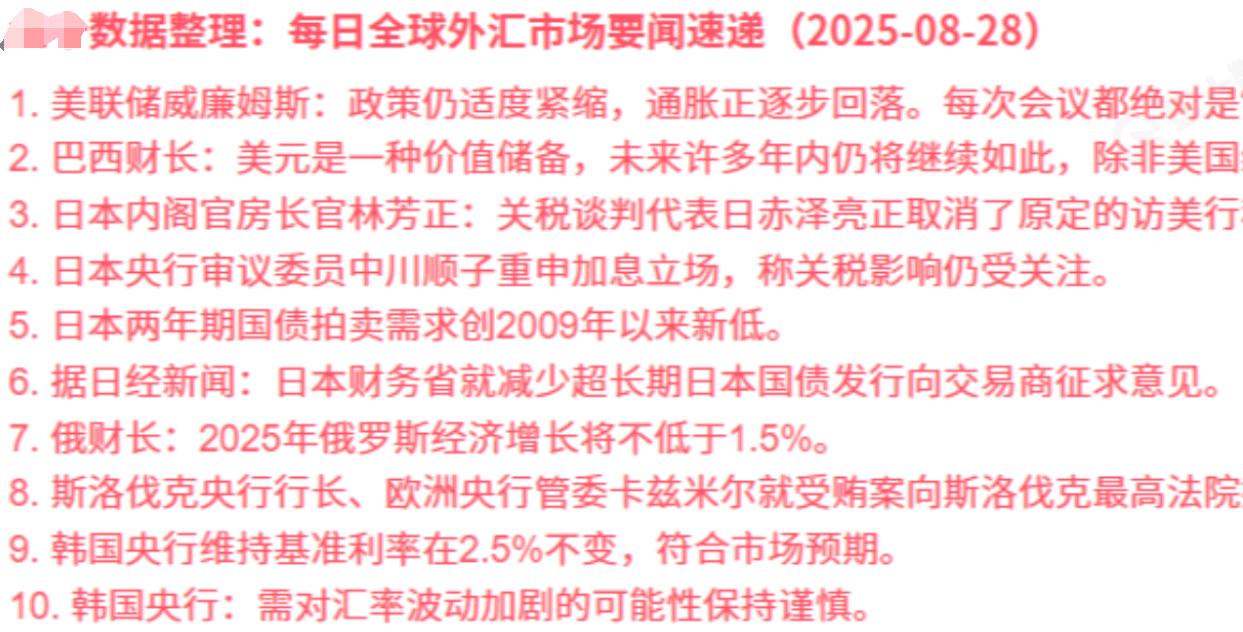I. The Federal Reserve: Tough Talk, Honest Actions
The Federal Reserve's number three, Williams, recently spoke as if walking a tightrope. Last year he insisted on continued rate hikes, but now he says the September meeting is data-dependent—translated, it means wait for the data before deciding. There are hidden stakes behind this shift:
Inflation Backlash: Core prices in the U.S. are still high at 3%, far from the 2% target. Minutes from the July meeting show most officials believe inflation risk is scarier than employment risk. Data Alert Level: If August's employment exceeds expectations or inflation rebounds, the Federal Reserve may instantly flip to a hawkish stance. Gold's 8% drop in April was indeed scared off by similar expectations.
Personal View: The Federal Reserve is like a student cramming before an exam—claiming to have studied well, but actually staying up late to finish assignments. Powell just turned dovish on August 24, but let's not forget that the ECB also tried this trick in 2024, which led to the euro rising before crashing.

II. The Asian Predicament: Japan and South Korea Are Both Under Attack
The Bank of Japan's Split Personality on Display:
On one hand, they call for rate hikes to combat inflation, while on the other, they allow government bonds to go unsold. Why such contradiction?
→ The Real Dilemma: Rate hikes could crush government debt (a 1% interest rate rise means an additional 3.7 trillion yen in interest for Japan's bonds), but rising prices make citizens' wages effectively shrink (real wages dropped by 2.9% in May). The Tariff Counterattack: After Japan canceled talks with the U.S., it threatened to retaliate while secretly reducing long-term bond issuance—this combination is actually to prevent the widening of the U.S.-Japan interest rate gap, which would cause the yen to collapse even harder (it has already fallen to the 150 level).
South Korea's Exchange Rate Defense Battle:
The central bank stubbornly maintains a 2.5% interest rate, but the won has depreciated over 5% against the dollar this year. In April, Korea used $3 billion of foreign exchange reserves to stabilize the market, leading to a single-month drop of $6 billion in reserves—what was the effect? After a brief rebound, it continued to fall. Personal Case: After South Korea intervened in the forex market in 2024, the won recovered to the 1,400 level, but the same tactic failed this year, indicating that under dollar hegemony, small countries become increasingly passive the more they struggle.
III. Emerging Markets: Some Are Turning Tables, Some Are Holding On
Brazil Leads the Charge Against the Dollar:
The finance minister directly stated that the weaponization of the dollar accelerates its decline. This is not just hot air—data supports it: global central banks bought over 1,000 tons of gold in 2024, and in the first quarter of 2025, they bought another 244 tons, causing the dollar's reserve ratio to drop to 58%.
Russia's Face-saving Project:
The Russian finance minister boasts that the economy will grow by 1.5% in 2025, but the market consensus is only 0.8%-1.2%. This 'expectation gap' is driven by political pressure to push energy dumping, which could disrupt global supply chains.
Central Bank Governor's Personal Observation: Emerging markets are being forced to take sides. India claims it wants to be self-sufficient, while Indonesia's stock market plummets due to political turmoil—under Trump's tariff stick, without real capability, it's hard to hold on.
IV. Investment Insights: Three Dangerous Signals
Policies Say One Thing, Do Another:
The Bank of Japan calls for rate hikes but secretly supports the bond market, just like the ECB's 'hawkish talk + secret bond purchases' routine in 2024, both leading to monetary collapse.
Official Data Is Inflated:
Russia boasts about GDP growth, but the market directly counters—this kind of deviation often indicates a worse fundamental situation (like the actual decline in energy exports after the Russia-Ukraine conflict).
Market Intervention Tools Address Symptoms, Not Root Causes:
Korea spends money to stabilize its currency but keeps falling, proving that under dollar hegemony, small countries only have band-aids, not surgical knives.
V. Practical Strategy: Focus on Key Actions, Don't Listen to Pretty Words
What is the Fed's 'live meeting' focusing on? Whether core PCE can drop below 2.5%, and whether August's non-farm payrolls will be below 150,000—these are the real signals. Japan's central bank shouldn't just listen to rate hikes: Look at whether the Ministry of Finance actually reduces long-term bond issuance (which is much more concrete than just rhetoric). If capital flows out of Korea: it may be forced into a dual assault of 'rate hikes + foreign exchange controls' (refer to South Korea's dollar purchases for intervention in Q4 2023). Why can gold surge to $4,000? Global central banks' net purchases of gold in Q1 of 244 tons provide a floor; the more chaotic the policy, the crazier the demand for safe-haven assets.
Finally, let's be practical:
Policymakers are human too; what they say doesn't always match what they do. When Japanese government bonds go unsold and the Fed says it will assess the situation, and when South Korea tries to save its currency but gets deeper into trouble—these twisted moments may actually signal a market shift. Just like gold surged in 2024 as central banks bought aggressively, chaos is rising again, and opportunities may be knocking.
Fitch's Governor's team specializes in serving ambitious maniacs! Follow Governor Fitch as he helps you navigate the market obstacles.
